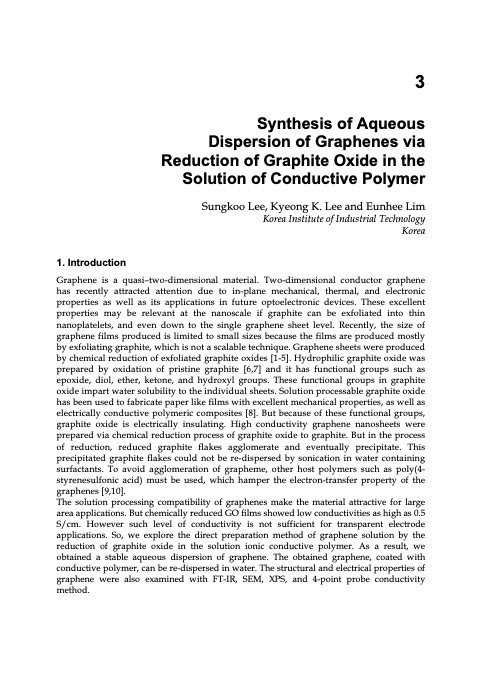PDF Publication Title:
Text from PDF Page: 047
1. Introduction 3 Synthesis of Aqueous Dispersion of Graphenes via Reduction of Graphite Oxide in the Solution of Conductive Polymer Sungkoo Lee, Kyeong K. Lee and Eunhee Lim Korea Institute of Industrial Technology Korea Graphene is a quasi–two-dimensional material. Two-dimensional conductor graphene has recently attracted attention due to in-plane mechanical, thermal, and electronic properties as well as its applications in future optoelectronic devices. These excellent properties may be relevant at the nanoscale if graphite can be exfoliated into thin nanoplatelets, and even down to the single graphene sheet level. Recently, the size of graphene films produced is limited to small sizes because the films are produced mostly by exfoliating graphite, which is not a scalable technique. Graphene sheets were produced by chemical reduction of exfoliated graphite oxides [1-5]. Hydrophilic graphite oxide was prepared by oxidation of pristine graphite [6,7] and it has functional groups such as epoxide, diol, ether, ketone, and hydroxyl groups. These functional groups in graphite oxide impart water solubility to the individual sheets. Solution processable graphite oxide has been used to fabricate paper like films with excellent mechanical properties, as well as electrically conductive polymeric composites [8]. But because of these functional groups, graphite oxide is electrically insulating. High conductivity graphene nanosheets were prepared via chemical reduction process of graphite oxide to graphite. But in the process of reduction, reduced graphite flakes agglomerate and eventually precipitate. This precipitated graphite flakes could not be re-dispersed by sonication in water containing surfactants. To avoid agglomeration of grapheme, other host polymers such as poly(4- styrenesulfonic acid) must be used, which hamper the electron-transfer property of the graphenes [9,10]. The solution processing compatibility of graphenes make the material attractive for large area applications. But chemically reduced GO films showed low conductivities as high as 0.5 S/cm. However such level of conductivity is not sufficient for transparent electrode applications. So, we explore the direct preparation method of graphene solution by the reduction of graphite oxide in the solution ionic conductive polymer. As a result, we obtained a stable aqueous dispersion of graphene. The obtained graphene, coated with conductive polymer, can be re-dispersed in water. The structural and electrical properties of graphene were also examined with FT-IR, SEM, XPS, and 4-point probe conductivity method.PDF Image | GRAPHENE SYNTHESIS CHARACTERIZATION PROPERTIES

PDF Search Title:
GRAPHENE SYNTHESIS CHARACTERIZATION PROPERTIESOriginal File Name Searched:
Graphene-Synthesis.pdfDIY PDF Search: Google It | Yahoo | Bing
Salgenx Redox Flow Battery Technology: Power up your energy storage game with Salgenx Salt Water Battery. With its advanced technology, the flow battery provides reliable, scalable, and sustainable energy storage for utility-scale projects. Upgrade to a Salgenx flow battery today and take control of your energy future.
CONTACT TEL: 608-238-6001 Email: greg@infinityturbine.com (Standard Web Page)